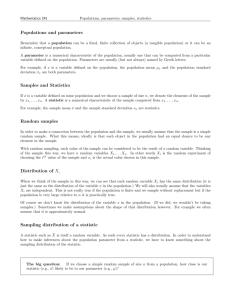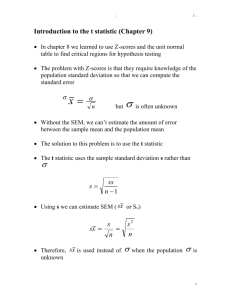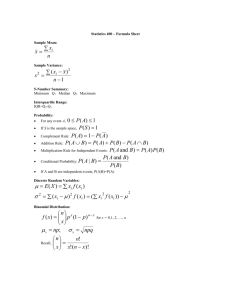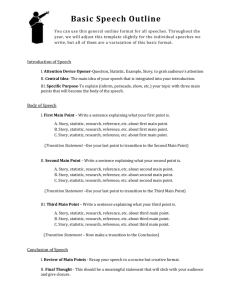Time Series Analysis
advertisement
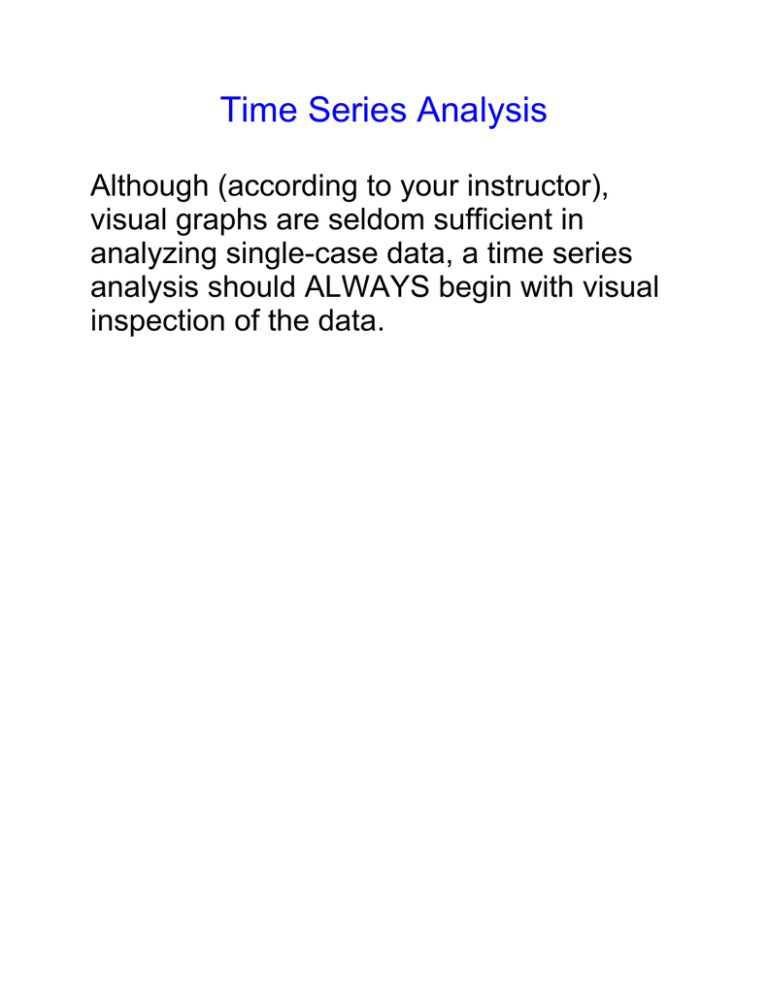
Time Series Analysis Although (according to your instructor), visual graphs are seldom sufficient in analyzing single-case data, a time series analysis should ALWAYS begin with visual inspection of the data. Visual analysis is typically based on three features. 1.level, 2.trend, 3.variability You can quantify the level, by simply calculating the mean score for each phase. For example, if the sample data in the single-case statistical analysis program represented baseline, treatment, and follow-up phases, the levels would be: Baseline = 4.12 Treatment = 8.00 Follow-up = 6.37 http://www.unlv.edu/faculty/pjones/singlecase/scsastat.htm The trend in the data is evaluated by two features: 1. slope (going up or going down), 2. magnitude (how rapidly going up or going down) You can quantify the variability, by simply calculating the standard deviation of scores within each phase. For example, if the sample data in the single-case statistical analysis program represented baseline, treatment, and follow-up phases, the variability would be: Baseline = 1.246 Treatment = .925 Follow-up = 1.597 Of the three features: level, trend, and variability, determining level and variability can be readily seen on the graph and quantitative descriptors are easily calculated. It is often also not difficult to assess the slope of a trend with visual analysis alone. The complication comes with determining the magnitude of the trend. There are many statistical techniques available to assist in evaluating the magnitude of a trend but by far the easiest to use is the C statistic featured in the single case statistical analysis program. There are few assumptions for its use regarding the form of the data (for example, test scores, teacher or self ratings, absentee counts, etc.) can be used and it fits easily into a clinical practice. There will, however, be times when visual analysis may be your only choice. Some examples would be: 1. When you were unable to obtain the minimum of 8 data points per phase. 2. When you were unable to obtain a stable baseline. There is also a nonparametric time series analysis procedure based on the chi square statistic. We'll explore that option later. Because the C statistic does not require a special form of data, it will usually be a better choice for time series analysis. Time Series Analysis with the C Statistic All investigations do (or should) consider whether there was significant change after treatment is introduced. The answer requires definition of the term significant. At least three types of significance warrant consideration: 1.practical, 2.theoretical, 3.statistical Practical significance deals whether there was sufficient change to make a difference in a person's life; Theoretical significance relates to whether the change came in a form consistent with a particular theory. Statistical significance is about whether the observed change would be likely to have occurred by chance alone. In actual practice settings, the most useful tool for the clinical scientist to assess statistical significance in single-case design is often a simplified form of time series analysis based on Young's C statistic. The C statistic is easily computed, makes few assumptions about the form of the data, and fits readily into the data gathering process in clinical practice. The number of required data points for use of the C statistic is significantly less than the number needed for more sophisticated time series analysis tools. Time series analysis with the C statistic identifies whether a trend, defined as any systematic departure from random variation, is evident in the set of data. The null hypothesis for the C statistic is that there is no trend. For example, there is no indication of significant departure from randomness in the sequence: 5-5-5-5-4-5-4-5. The C statistic would be evaluated as not statistically significant; the null hypothesis would not be rejected. In contrast, the sequence: 1-2-3-4-5-6-7-8 is a departure from random fluctuation; the C statistic is evaluated as statistically significant; the null hypothesis is rejected. The formula to calculate the C statistic is: n-1 S (Xi - Xi+1) 2 i=1 ________________ C=1n 2 S (Xi - Mx) 2 i=1 but, I think you would prefer to go here: http://www.unlv.edu/faculty/pjones/singlecase/scsastat.htm The more sophisticated forms of time series analysis require 50 to 100 data points in each phase. But, the C statistic can be used when there are at least 8 measures in each phase. The logic of the C statistic with actual practice data is to continue baseline measures until there is no evident random variation, until in effect the baseline is horizontally stable with no evident trend. Then, treatment begins; measurement continues, and the treatment data are appended to the baseline data to assess whether a trend, a departure from random variation, becomes evident. With the time series analysis, you can investigate: 1.whether a trend was evident even before treatment began, 2.whether a trend is evident within the treatment itself, 3.whether the addition of the treatment created change greater than would be expected from random variation, and 4.what happens after the treatment stops. Baseline: C = .206, z = .668, p > .05. Treatment: C = .215, z = .697, p > .05. Follow-up: C = .009, z = .029, p > .05. B + T: C = .540, z = 2.306, p < .05. B + F: C = .509, z = 2.174, p < .05. T + F: C = .045, z = .192, p > .05. What do these results mean? Are they a desired outcome?


